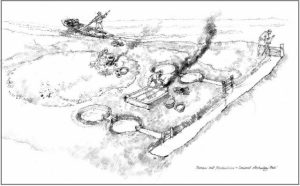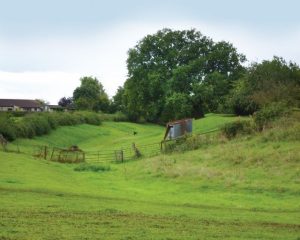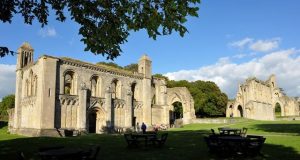
Timeline – Romans to Rebellion
Introduction
This period in the Avalon Marshes’ history covers from when the Romans arrived in AD 43 through the huge change which came with the monasteries. During this period the power and wealth of the church started to shape the landscape we see today. After this came dissolution under the Tudors, periods of civil war and later the Monmouth rebellion. These all slowed the pace of drainage and improvement.
The Romans 43-410
Vikings and Anglo-Saxons 410-1066
The Normans 1066-1154
Middle Ages 1154-1485
Tudors, Civil War and Rebellion 1485-1714
The Romans 43-410

Roman – Saltern
Landscape
The raised bogs were still growing and tidal creeks reached the edges of the “island” of Burtle.
History
The nearby hills are farmed and settled with roads and villas being built. The creeks are exploited with salt being produced from the saline water using “Salterns” formed from local clay. A sideline of the salt producers was forging coins! The clay was used for the moulds, transport by water would be good and the locations were remote. Did dangerous times come at the end of Roman rule? On Shapwick Heath six hoards of pewter and bronze vessels, and valuable coins were found in 1936 by a peat digger. Were these buried by owners who never returned?
What to do / Where to go
Visit the replica Romano British building (under construction) at the Avalon Marshes Centre. Explore the landscape of salterns and forging by cycling our Peat Moors and Roman Saltworks route.
Vikings and Anglo-Saxons 410-1066

Dark Ages? – Ponter’s Ball
LANDSCAPE
No great change other than the peat continues to get thicker.
HISTORY
An age of war, change and Christianity. This created legends of kings and saints that were associated with the area. We know that a “Dark Age” settlement was constructed on the top of the Tor, later to be replaced by an Anglo-Saxon monastery. Ponter’s Ball may have been built during the Dark Ages to “protect” the Isle of Avalon. By the end of this period the Vikings have been defeated, England created and Glastonbury Abbey was the wealthiest monastic house in the land.
What to do / Where to go
Visit Ponter’s Ball and then climb up the hill behind West Pennard Church, the view is magnificent. Look across at the Tor and imagine the huge cultural importance of that first monastery. Our Eastern Moors cycle route gives you magnificent views of the Tor and takes in West Pennard. Visit the replica Anglo Saxon Long Hall (under construction) based on one which was discovered at Cheddar at the Avalon Marshes Centre.
The Normans 1066-1154
History
Order followed by anarchy – the Doomsday Book is created and then followed the Anarchy, the period when cousins Matilda and Stephen fought for the crown. The Doomsday Book gives us an insight into Avalon Marshes communities as they were. Many motte and bailey castles, such as that at Fenny Castle, were built at that time as much as a symbol of power as for practical defence.
Middle Ages– 1154-1485
Landscape
 The start of significant changes to the landscape of the Avalon Marshes. Rivers are diverted, land drained, woodland managed and stock is grazed.
The start of significant changes to the landscape of the Avalon Marshes. Rivers are diverted, land drained, woodland managed and stock is grazed.
History
Glastonbury Abbey’s estate extends over most of the Avalon Marshes and the rest is under the control of the Dean and Bishop of Wells. Burtle, Beckery, Godney and Meare were all important to the Abbey, in particular Meare with its huge lake. The marshes are a huge natural resource of fish, fowl, grass for grazing, timber for building, peat for burning and reeds for thatching. The wealth of the Abbey grows and so does its influence on the area. You can read more on our Meare and the Abbey page.
What to do / Where to go
Visit Meare, see the Abbot’s Fish House and the impressive manor and marvel at the power and wealth of an institution which would soon be no more.
Tudors, Civil War and Rebellion 1485-1714

Tudor – Dissolution of the Abbey Glastonbury Abbey
Landscape
Drainage of the marshes and agricultural improvement continues but at a slower pace. However, by 1700 roughly fifty percent of the marshes were enclosed and drained for agriculture. The other areas remained as common land including large areas of mire and bog.
History
15 November 1539 was a day of significant change in the way the marshes were managed. On this day the final abbot of Glastonbury Abbey was hanged at the top of the Tor. This was followed by the demolition of the abbey and the dispersal of its lands and wealth. Further death and instability followed including the Civil War and Monmouth rebellion. These troubled times slowed the pace of improvement, gone was one powerful controlling body. Natural disasters also hit the area; 20th January 1607 saw a great flood, possibly a tsunami, reach Glastonbury.
What to do / Where to go
Visit Glastonbury Abbey see what remains and learn more about its history and legacy. Cycle our Reserves & Lake Villages route to see the mixed landscape of the marshes and the remains of Abbey’s influence.